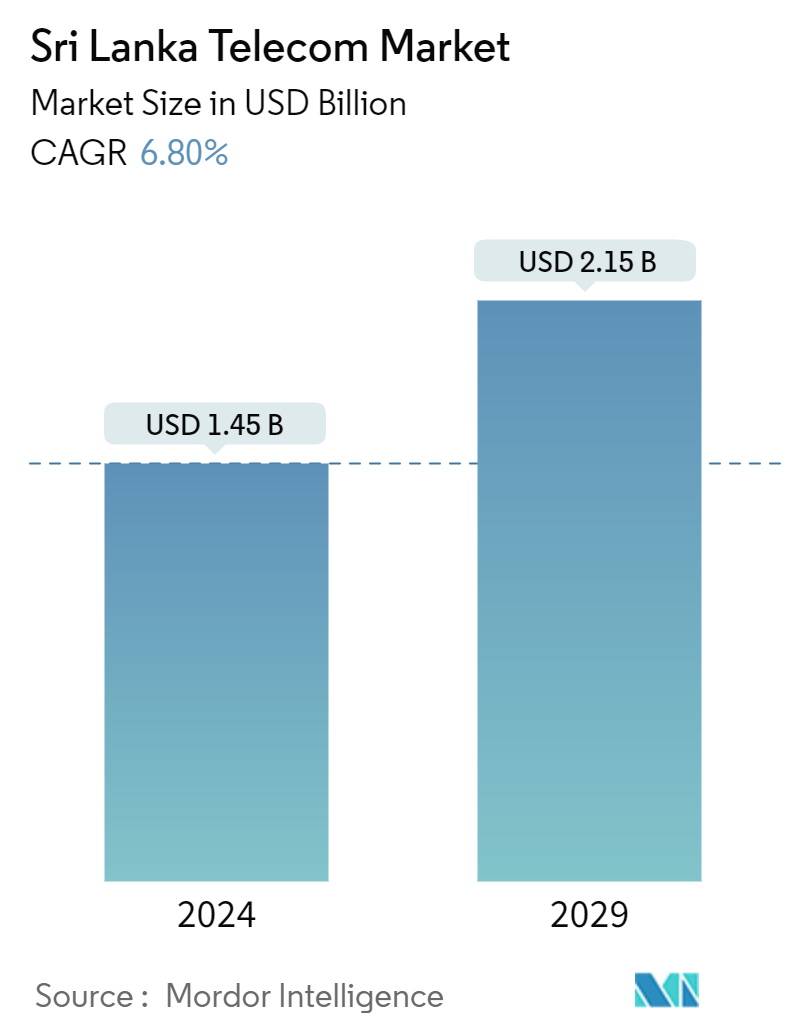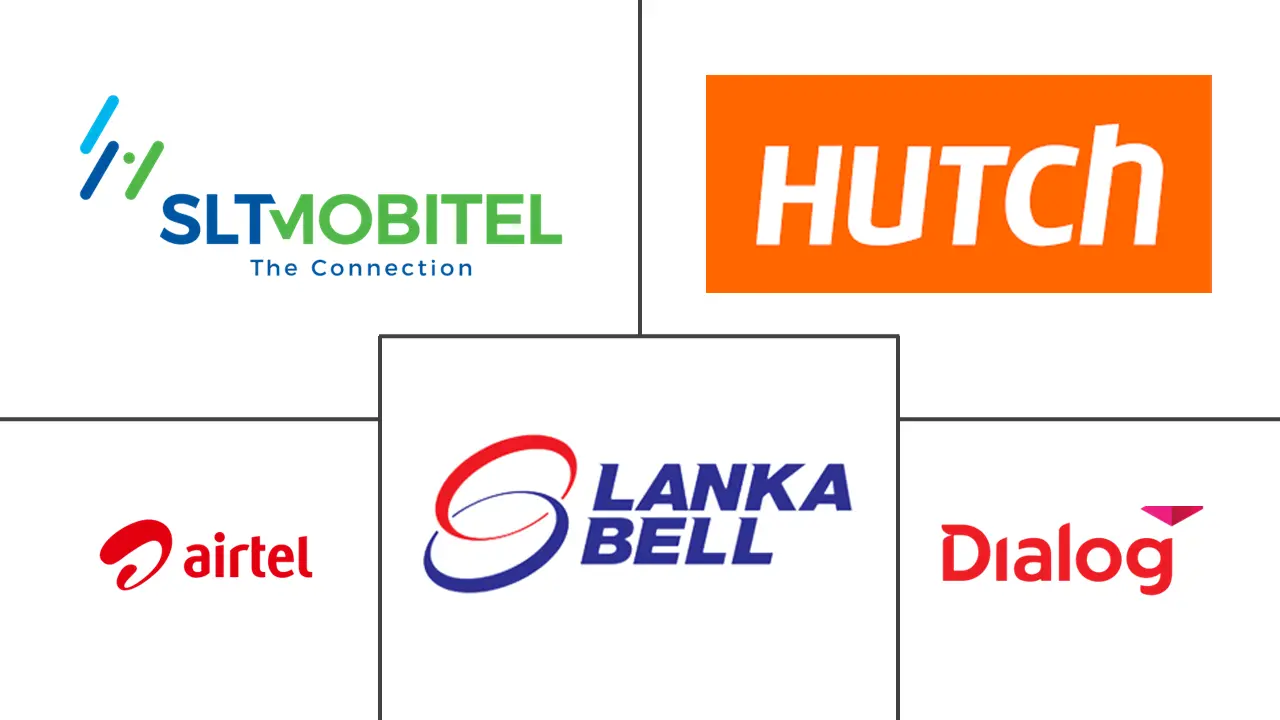Market Size of Sri Lanka Telecom Industry

| Study Period | 2019 - 2029 |
| Base Year For Estimation | 2023 |
| Market Size (2024) | USD 1.45 Billion |
| Market Size (2029) | USD 2.15 Billion |
| CAGR (2024 - 2029) | 6.80 % |
| Market Concentration | Medium |
Major Players
*Disclaimer: Major Players sorted in no particular order |
Sri Lanka Telecom Market Analysis
The Sri Lanka Telecom Market size is estimated at USD 1.45 billion in 2024, and is expected to reach USD 2.15 billion by 2029, growing at a CAGR of 6.80% during the forecast period (2024-2029).
Sri Lanka is investing heavily in expanding its 4G LTE and fiber optic networks. Major telecom operators like Sri Lanka Telecom (SLT), Dialog Axiata, and Airtel are upgrading their networks to offer faster and more reliable internet services. For instance, SLT is working on the SEA-ME-WE 6 cable system to enhance international connectivity, which is expected to be completed by 2025.
- The government collaborates with private telecom providers to address connectivity issues, mainly in rural areas. Initiatives like the Gamata Sannivedanaya project seek to deliver broadband coverage nationwide, facilitating online education and other digital services. In May 2024, Sri Lanka's government proposed plans to allow third-party companies to build telecom towers. The government also aims to build 276 towers to improve connectivity across the country and support its target of growing the digital economy to USD 15 billion in 2030 from last year's USD 2.3 billion.
- Furthermore, the push toward digital transformation is evident as telecom companies introduce various digital services and innovations. Hutch, for example, is driving a digital vision for inclusive growth by expanding its 4G and 5G-ready network across Sri Lanka. In January 2024, Indian telco Reliance Jio was named one of three interested parties considering purchasing the Sri Lankan government's 50.23% stake in the state-owned firm Sri Lanka Telecom.
- Sri Lanka's information and communication technology (ICT) sector, including IT/ITES and telecommunications, aims to contribute USD 3 billion to the economy by 2024 through export revenue. This is part of a broader plan to reach USD 15 billion in digital economy contributions by 2030, aligning with the country’s Sustainable Development Goals (SDG). According to the Federation of Information Technology Industry Sri Lanka (FITIS), the country will enter the third wave of technology during the digital transformation, with 750 tech companies, 1,000 IT and IT-infused startups, and 500 other technology startups in place.
- Sri Lanka's telecom industry made further strides in expanding its network capacity with fiber and wireless deployments. For instance, Sri Lanka Telecom (SLT) offers customers Wi-Fi hotspots. These wireless broadband services help customers by providing high-speed connectivity services. Moreover, Sri Lanka Telecom (SLT) proposed the SEA-ME-WE 6 cable system to link Western Europe, the Middle East, and Southeast Asia. This project is expected to be completed at the end of 2025. Key players in the telecom market are expected to further support the growth of the market by investing in fiber cables to offer high-speed connectivity services for customers.
- Inflation can impact the cost of borrowing and the availability of capital. Telecom companies may find it more expensive to finance new projects or upgrade infrastructure, potentially slowing down expansion and modernization efforts. Rising infrastructure, equipment, and services costs can lead to higher expenses for telecom operators. This can reduce profit margins unless costs are passed on to consumers.
Sri Lanka Telecom Industry Segmentation
Telecom or telecommunication is the long-range transmission of information by electromagnetic means.
Sri Lanka's telecom market is segmented by services (voice services [wired and wireless], data and messaging services (coverage to include internet and handheld data packages, as well as package discounts), and OTT and servicespayTV services. The impact of macroeconomic trends on the market is also covered under the scope of the study. The impact of factors affecting the market's evolution in the near future, such as drivers and constraints, are also covered in the study. The market sizes and forecasts are provided in USD for all the above segments.
| By Services | ||||
| ||||
| Data and Messaging Services (Coverage to Include Internet & Handset Data Packages as well as Package Discounts) | ||||
| OTT and PayTV Services |
Sri Lanka Telecom Market Size Summary
The Sri Lanka telecom market is poised for significant growth, driven by the presence of major global telecom companies like Dialog Axiata, Airtel, and Hutchison Telecommunications Lanka. These companies are actively investing in research and development to foster innovation and expand their service offerings. The market is experiencing a gradual transition from 3G and 4G networks to 5G, with key players conducting trials and demonstrations to pave the way for full deployment. The expansion of network capacity through fiber and wireless deployments, such as Sri Lanka Telecom's Wi-Fi hotspots and the SEA-ME-WE 6 cable system, is enhancing connectivity across the country. Initiatives like the Gamata Sannivedanaya project aim to address connectivity issues in rural areas, further supporting market growth.
The increasing adoption of mobile-based OTT services is creating new opportunities for the telecom market, with providers like Sri Lanka Telecom launching streaming services in partnership with digital media companies. The demand for high-speed connectivity is being met by the deployment of next-generation fiber optic cable systems and the expansion of 5G networks. Collaborations between government authorities and private telecom service providers are focused on expanding wireless broadband connections. The market is moderately fragmented, with ongoing partnerships and advancements among key players such as Dialog Axiata, Airtel, Hutchison Telecommunications Lanka, SLTMobitel, and Lanka Bell. These developments are expected to drive further growth in the telecom sector, supported by initiatives like the successful trial of a 5G Standalone network and the expansion of mobile and internet coverage in the region.
Sri Lanka Telecom Market Size - Table of Contents
-
1. MARKET INSIGHTS
-
1.1 Market Overview
-
1.2 Industry Ecosystem Analysis
-
1.3 Industry Attractiveness - Porter's Five Forces Analysis
-
1.3.1 Bargaining Power of Suppliers
-
1.3.2 Bargaining Power of Consumers
-
1.3.3 Threat of New Entrants
-
1.3.4 Threat of Substitute Products
-
1.3.5 Intensity of Competitive Rivalry
-
-
1.4 Impact of Key Macroeconomic Trends on the Market
-
1.5 Regulatory Landscape in Sri Lanka
-
-
2. MARKET SEGMENTATION
-
2.1 By Services
-
2.1.1 Voice Services
-
2.1.1.1 Wired
-
2.1.1.2 Wireless
-
-
2.1.2 Data and Messaging Services (Coverage to Include Internet & Handset Data Packages as well as Package Discounts)
-
2.1.3 OTT and PayTV Services
-
-
Sri Lanka Telecom Market Size FAQs
How big is the Sri Lanka Telecom Market?
The Sri Lanka Telecom Market size is expected to reach USD 1.45 billion in 2024 and grow at a CAGR of 6.80% to reach USD 2.15 billion by 2029.
What is the current Sri Lanka Telecom Market size?
In 2024, the Sri Lanka Telecom Market size is expected to reach USD 1.45 billion.

